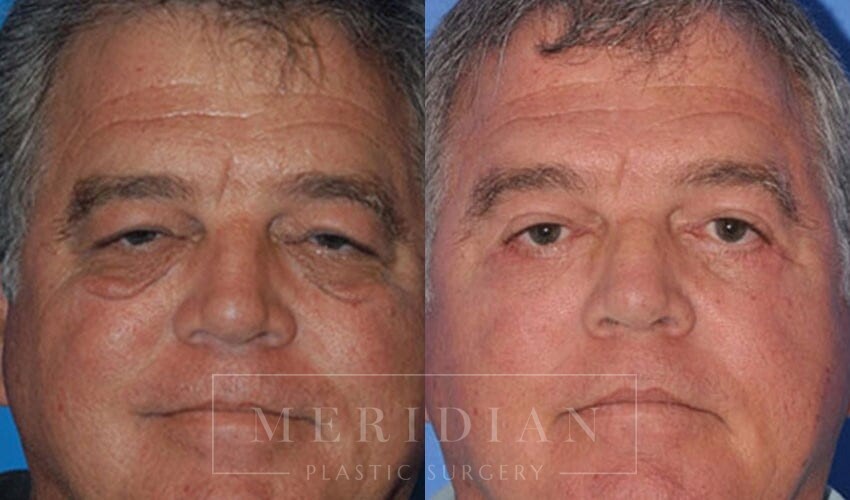About the Blepharoplasty Procedure
Have you been told that you look tired even though you’re wide awake? Do you have deep under-eye circles that you just can’t seem to hide no matter how much makeup you apply? If so, it may be time for you to consider blepharoplasty also known as eyelid surgery.

Your eyes have an important effect on the way your face looks, and they are one of the first features of your face that make an impression when you meet new people. For this reason, a subtle revision or restoration through blepharoplasty can make a significant improvement in your appearance, especially if you have drooping or sagging upper eyelids that make you look more tired than you are, make it difficult for you to see, or if you have severe under-eye bags or depressions.
Is Blepharoplasty for You?
Dr. Tjelmeland may recommend patients have the procedure to address a number of upper eyelid and lower eyelid issues, including:
- Wrinkles and deep lines caused by aging and sun exposure.
- Puffiness or heavy lids caused by hereditary factors.
- Loose skin that causes hooding of the eyes.
- Droopy eyelids that affect your vision.
- Lower eyelid puffiness or sagging that always make you look tired.
Blepharoplasty can improve each of these conditions by revising the upper lids, lower lids, or both. You may also choose to have another facial surgery during the same surgical session, such as a brow lift or facelift.
Types of Blepharoplasty Procedures
Lower Blepharoplasty
Lower Blepharoplasty targets the lower eyelids to address issues like puffiness, wrinkles, dark circles and excess skin. Dr. Tjelmeland typically removes or repositions fat, tightens muscles, and trims excess skin to rejuvenate the lower eye area. This procedure aims to create a more youthful and refreshed appearance by restoring a smoother contour to the lower eyelids.
Upper Blepharoplasty
Upper Blepharoplasty focuses on the upper eyelids to address sagging skin, excess fat, and drooping. During the surgery, Dr.Tjelmeland removes excess skin and fat and tightens the remaining tissues to enhance the eyelid’s appearance. This procedure reduces the heaviness of the upper eyelids, reduces the hooding which can sometimes obstruct vision, and gives the eyes a brighter more youthful look.
How Blepharoplasty Works
Blepharoplasty can restore a more youthful appearance to your eyes and provide you with better vision if loose skin is interfering with your ability to see. Most Austin blepharoplasty patients can have the procedure on an outpatient basis—usually under light sedation—in our specialized surgical facility.
Your surgery will depend on the goals that you and Dr. Tjelmeland establish during your initial consultation. In a typical procedure:
- Dr. Tjelmeland makes incisions in locations that work with the natural folds and creases of the eyelid. This provides you with a natural-looking, subtle change.
- For the upper eyelids, Dr. Tjelmeland creates an incision in the crease of the eyelid. He excises unwanted skin and removes fat deposits.
- For the lower eyelids, he makes the incision on the inside of the eyelid or under the eyelash line to remove the excess skin and fatty tissue. Your surgery may include tightening of the muscles in your eyelids to resolve severe laxity.
With all blepharoplasty procedures, Dr. Tjelmeland uses a gentle approach. His goals are to make you appear refreshed, and more alert than you previously did and to help you look as great as you feel on the inside!
Recovery After A Blepharoplasty Procedure
After your surgery, you can control any discomfort with pain medication that Meridian Plastic Surgery Center will recommend. Your eyes may be swollen and bruised for about 7-10 days, and you’ll want to avoid wearing any makeup while your eyes are healing.
Most patients can return to normal activity and wear makeup within about one week. The full benefits of the procedure are evident after about two weeks. At this point, you can expect a younger, more refreshed appearance.
Frequently Asked Questions
Am I A Good Candidate For Blepharoplasty Surgery?
In order to be a good candidate for blepharoplasty surgery, Austin patients will be evaluated by Dr. Tjelmeland to determine if:
- You’re in good general health.
- You have communicated to Dr. Tjelmeland that you have realistic expectations for your procedure.
- You are a non-smoker, as smoking can complicate both the blepharoplasty surgery and recovery.
- You are in good overall psychological health.
Are The Results Of Blepharoplasty Permanent?
While blepharoplasty surgery can definitely turn back the hands of time and will make you look younger and more alert, it’s important to remember that the aging process never ends. As you continue to age years and even decades down the road, it’s possible that your drooping, sagging eyelids will return.
Many of Dr. Tjelmeland’s patients are understandably concerned about the option of needing repeat surgical procedures, especially for droopy eyelids which can’t be controlled via diet or exercise. The answer is that while it is rare for a patient to require a second blepharoplasty surgery, depending on the age skin and goals, sometimes a secondary surgery is desired.
Excellence in Blepharoplasty in Austin, TX
Schedule A Blepharoplasty Consultation At Meridian Plastic Surgery Center Today
If you’re unhappy with your sagging eyelids, blepharoplasty surgery is a fantastic way to rejuvenate your appearance. Call Meridian Plastic Surgery Center’s Austin offices at (512) 617-7500 or fill out our online form to inquire electronically.



